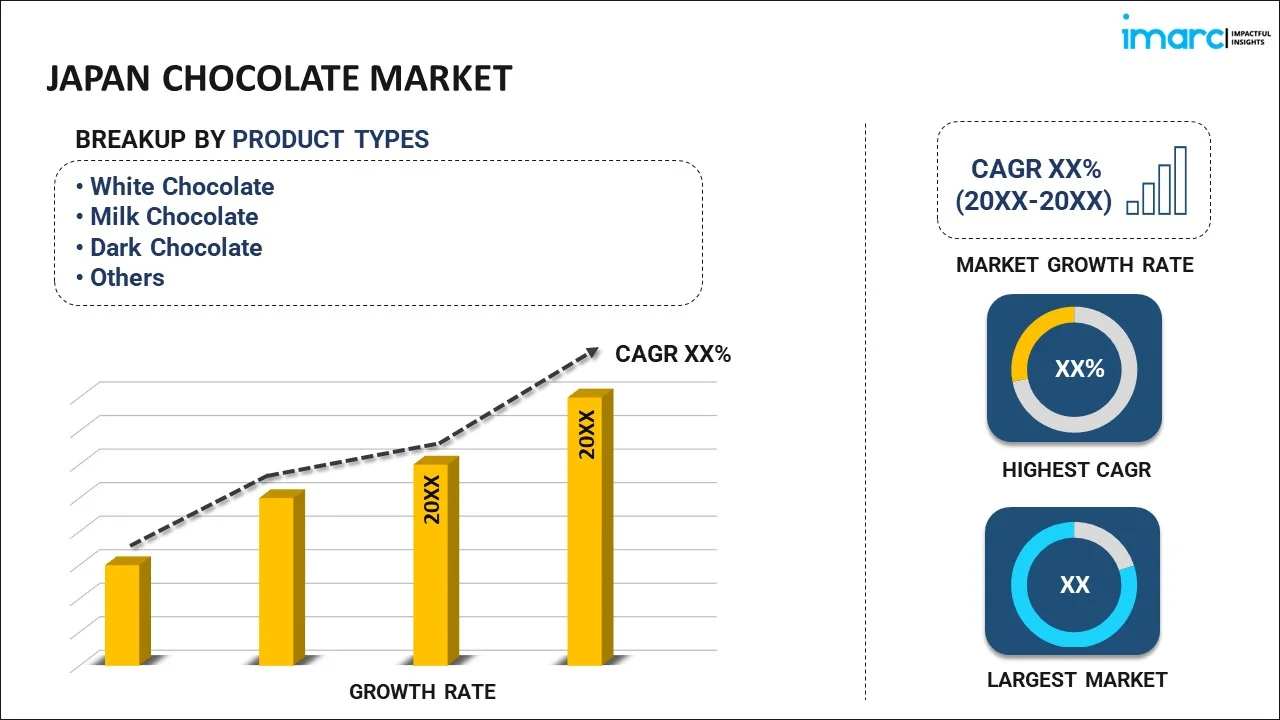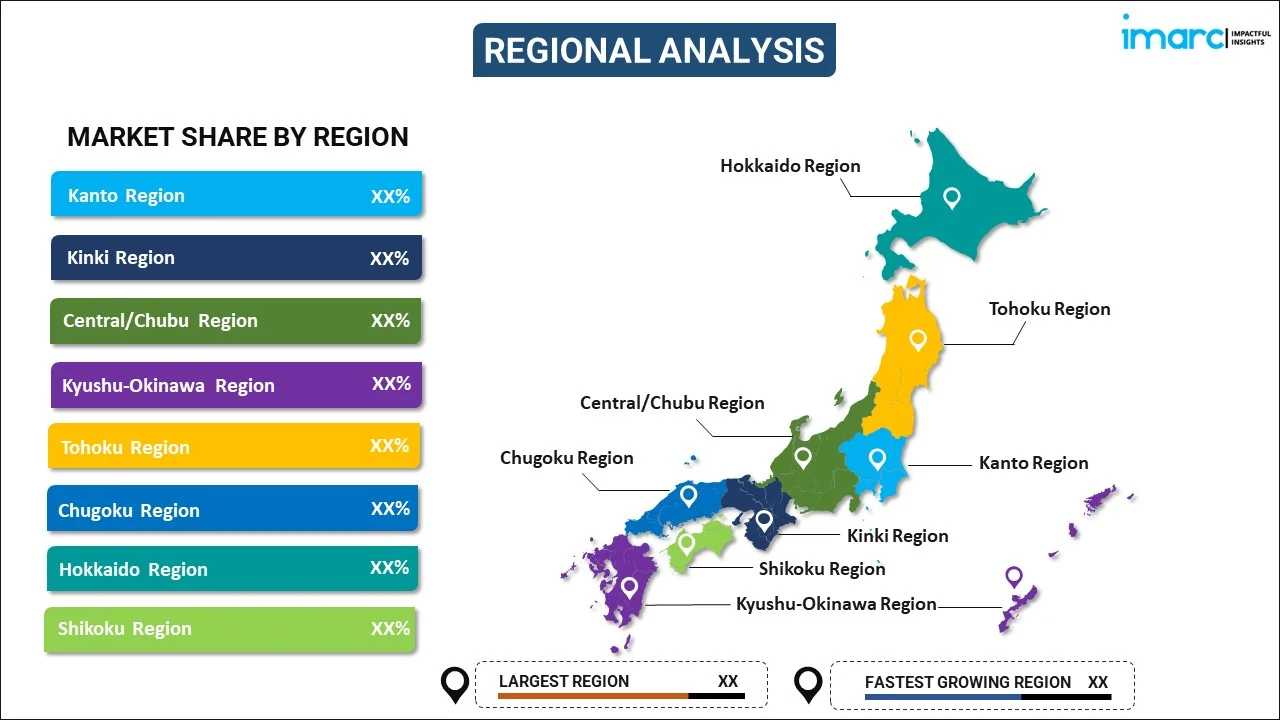
Japan Chocolate Market Report by Product Type (White Chocolate, Milk Chocolate, Dark Chocolate, and Others), Product Form (Molded, Countlines, and Others), Application (Food Products, Beverages, and Others), Pricing (Everyday Chocolate, Premium Chocolate, Seasonal Chocolate), Distribution (Direct Sales (B2B), Supermarkets and Hypermarkets, Convenience Stores, Online Stores, and Others), and Region 2025-2033
Market Overview:
The Japan chocolate market size is projected to exhibit a growth rate (CAGR) of 3.85% during 2025-2033. The rising awareness of the health benefits of dark chocolate, which contains antioxidants, the increasing consumer preference for premium and quality chocolates, and the accelerating consciousness towards sustainability represent some of the key factors driving the market.
|
Report Attribute
|
Key Statistics
|
|---|---|
|
Base Year
|
2024
|
|
Forecast Years
|
2025-2033
|
|
Historical Years
|
2019-2024
|
| Market Growth Rate (2025-2033) | 3.85% |
Chocolate is a beloved sweet treat made from cocoa beans, the seeds of the Theobroma cacao tree. It begins with the harvesting of these beans, which are fermented, dried, and roasted to bring out the distinctive chocolate flavor. The roasted beans are then ground into a paste called cocoa mass, containing both cocoa solids and cocoa butter. This mass can be further processed to produce cocoa powder and cocoa butter, essential ingredients in making various types of chocolate. Dark chocolate consists primarily of cocoa mass, sugar, and a small amount of cocoa butter. Milk chocolate includes milk solids or powder, giving it a creamier texture. White chocolate is made from cocoa butter, sugar, and milk solids, without cocoa solids, leading to its pale color. It is enjoyed worldwide in various forms, such as bars, truffles, or as an ingredient in baked goods. Its rich flavor, texture, and aroma have made it a popular indulgence, while the presence of antioxidants in dark chocolate has led to studies on potential health benefits. The production and consumption of chocolate also have significant impacts on global commerce, making it an important commodity in the world market.
Japan Chocolate Market Trends:
The Japan chocolate market is witnessing noticeable growth, fueled by the rising awareness of the health benefits of dark chocolate, which contains antioxidants. This is leading to an increased consumer preference for premium and quality chocolates. This has been coupled with the nation's strong tradition of gift-giving, where chocolates serve as a popular choice, especially during seasonal occasions, such as Valentine's Day and White Day. Additionally, the escalating café culture and the proliferation of specialty chocolate stores have contributed to an elevated consumption pattern. In addition, the influence of Western culture has also sparked a curiosity and acceptance of various chocolate flavors and textures. Japan's strong economy, urbanization, and the growth in disposable income are facilitating the market's expansion as well. Apart from this, innovations in packaging, aiming to appeal to the aesthetic sense of consumers, have become a significant trend in the market. In confluence with this, the rise in demand for organic, vegan, and ethically-sourced chocolates reflects a growing consciousness towards sustainability and environmental considerations. Furthermore, manufacturers are also focusing on unique and localized flavors, including matcha, wasabi, and sakura to cater to the distinctive palate of the Japanese consumers. This amalgamation of tradition and innovation, health consciousness, economic factors, and a shift towards sustainability is shaping the dynamics of the market, making it an attractive sector for both local and international players.
Japan Chocolate Market Segmentation:
IMARC Group provides an analysis of the key trends in each segment of the Japan chocolate market report, along with forecasts at the country level for 2025-2033. Our report has categorized the market based on product type, product form, application, pricing, and distribution.
Product Type Insights:

- White Chocolate
- Milk Chocolate
- Dark Chocolate
- Others
The report has provided a detailed breakup and analysis of the market based on the product type. This includes white chocolate, milk chocolate, dark chocolate, and others.
Product Form Insights:
- Molded
- Countlines
- Others
A detailed breakup and analysis of the market based on the product form have also been provided in the report. This includes molded, countlines, and others.
Application Insights:
- Food Products
- Bakery Products
- Sugar Confectionery
- Desserts
- Others
- Beverages
- Others
The report has provided a detailed breakup and analysis of the market based on the application. This includes food products (bakery products, sugar confectionery, desserts, and others), beverages, and others.
Pricing Insights:
- Everyday Chocolate
- Premium Chocolate
- Seasonal Chocolate
A detailed breakup and analysis of the market based on the pricing have also been provided in the report. This includes everyday chocolate, premium chocolate, and seasonal chocolate.
Distribution Insights:
- Direct Sales (B2B)
- Supermarkets and Hypermarkets
- Convenience Stores
- Online Stores
- Others
The report has provided a detailed breakup and analysis of the market based on the distribution. This includes direct sales (B2B), supermarkets and hypermarkets, convenience stores, online stores, and others.
Regional Insights:

- Kanto Region
- Kinki Region
- Central/ Chubu Region
- Kyushu-Okinawa Region
- Tohoku Region
- Chugoku Region
- Hokkaido Region
- Shikoku Region
The report has also provided a comprehensive analysis of all the major regional markets, which include Kanto Region, Kinki Region, Central/ Chubu Region, Kyushu-Okinawa Region, Tohoku Region, Chugoku Region, Hokkaido Region, and Shikoku Region.
Competitive Landscape:
The report has also provided a comprehensive analysis of the competitive landscape in the market. Competitive analysis such as market structure, key player positioning, top winning strategies, competitive dashboard, and company evaluation quadrant has been covered in the report. Also, detailed profiles of all major companies have been provided.
Japan Chocolate Market Report Coverage:
| Report Features | Details |
|---|---|
| Base Year of the Analysis | 2024 |
| Historical Period | 2019-2024 |
| Forecast Period | 2025-2033 |
| Units | Million USD |
| Scope of the Report | Exploration of Historical and Forecast Trends, Industry Catalysts and Challenges, Segment-Wise Historical and Predictive Market Assessment:
|
| Product Types Covered | White Chocolate, Milk Chocolate, Dark Chocolate, Others |
| Product Forms Covered | Molded, Countlines, Others |
| Applications Covered | • Food Products: Bakery Products, Sugar Confectionery, Desserts, Others • Beverages • Others |
| Pricings Covered | Everyday Chocolate, Premium Chocolate, Seasonal Chocolate |
| Distributions Covered | Direct Sales (B2B), Supermarkets and Hypermarkets, Convenience Stores, Online Stores, Others |
| Regions Covered | Kanto Region, Kinki Region, Central/ Chubu Region, Kyushu-Okinawa Region, Tohoku Region, Chugoku Region, Hokkaido Region, Shikoku Region |
| Customization Scope | 10% Free Customization |
| Post-Sale Analyst Support | 10-12 Weeks |
| Delivery Format | PDF and Excel through Email (We can also provide the editable version of the report in PPT/Word format on special request) |
Key Questions Answered in This Report:
- How has the Japan chocolate market performed so far and how will it perform in the coming years?
- What has been the impact of COVID-19 on the Japan chocolate market?
- What is the breakup of the Japan chocolate market on the basis of product type?
- What is the breakup of the Japan chocolate market on the basis of product form?
- What is the breakup of the Japan chocolate market on the basis of application?
- What is the breakup of the Japan chocolate market on the basis of pricing?
- What is the breakup of the Japan chocolate market on the basis of distribution?
- What are the various stages in the value chain of the Japan chocolate market?
- What are the key driving factors and challenges in the Japan chocolate?
- What is the structure of the Japan chocolate market and who are the key players?
- What is the degree of competition in the Japan chocolate market?
Key Benefits for Stakeholders:
- IMARC’s report offers a comprehensive quantitative analysis of various market segments, historical and current market trends, market forecasts, and dynamics of the Japan chocolate market from 2019-2033.
- The research study provides the latest information on the market drivers, challenges, and opportunities in the Japan chocolate market.
- Porter's five forces analysis assist stakeholders in assessing the impact of new entrants, competitive rivalry, supplier power, buyer power, and the threat of substitution. It helps stakeholders to analyze the level of competition within the Japan chocolate industry and its attractiveness.
- Competitive landscape allows stakeholders to understand their competitive environment and provides an insight into the current positions of key players in the market.
Need more help?
- Speak to our experienced analysts for insights on the current market scenarios.
- Include additional segments and countries to customize the report as per your requirement.
- Gain an unparalleled competitive advantage in your domain by understanding how to utilize the report and positively impacting your operations and revenue.
- For further assistance, please connect with our analysts.
 Inquire Before Buying
Inquire Before Buying
 Speak to an Analyst
Speak to an Analyst
 Request Brochure
Request Brochure
 Request Customization
Request Customization




.webp)




.webp)












